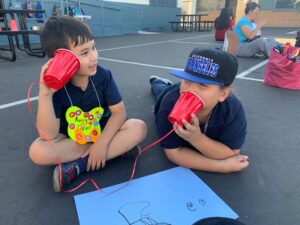What is an Auditory Learner?
An auditory learner is someone who learns by hearing and listening. They store information by the way it sounds, and have an easier time understanding spoken instructions than written ones.
How do I know if my child is an auditory learner?
Take the Quiz below.
[ays_quiz id=”2″]
Signs of an auditory learner include:
Moving lips when they read
Talking out loud to themselves and enjoy telling stories
Can remember and repeat what they’ve been told
Enjoy being read to
Are skilled at picking up on tone, pitch, and other changes in sound to understand someone’s emotions and intentions better
Like listening to music and may have a good sense of rhythm
Are easily distracted by silence or background noises
How to teach an auditory learner?
Congratulations, you’ve determined your child/student is an auditory learner! Now how do you move forward with that information while teaching them a new language? Here are some suggestions:
1. Encourage Active Listening
Active listening is a key skill for auditory learners. It involves paying close attention to what is being said and actively engaging with the material. Encourage active listening by asking your child to repeat vocabulary words out loud and provide opportunities for reflection and discussion after reading a story in another language.
2. Incorporate Sounds and Audios into Lessons
The right kind of noise will help an auditory learner excel and retain information better. Incorporate songs that go along with the language lesson and let dance parties happen. Don’t be surprised if you hear them singing the song later in the day. Put soft background music in the background while they read or do homework. Have them listen to audiobooks and watch Netflix/YouTube videos in the target language.
3. Provide opportunities for discussion
Auditory learners thrive in group discussions. Allowing a question and answer time in the middle of or after a lesson is critical for your child to verbalize their questions and interact with the material out loud. Oral presentations are also a good way to get them talking to start that ‘audio-memory’ feedback loop.
4. Don’t neglect the other styles of learning!
While it’s important to understand and play to the strengths of your child’s preferred learning style, children will actually learn best through multisensory learning when all the sensory modes (visual, auditory, kinesthetic) are engaged. Adding visual aids such as diagrams, charts, and pictures will help develop their visual perception. Adding hands-on activities, such as crafts and games will get their bodies moving.
Did you know that Cultural Bytes incorporates all three types of learning (visual, auditory, and kinesthetic) in our In Person and Online Classes? Don’t wait another day to sign your child up and find out what the fun is all about.

We play games like balloon toss (Kinesthetic).

We color and draw almost every day (Visual).

We play music and language games (Auditory).







